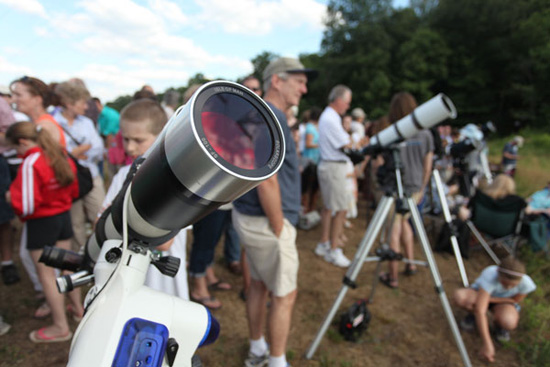
About 500 people gathered at Vanderbilt Dyer Observatory June 5 to see the 2012 transit of Venus across the sun, an event that astronomers say won’t happen again for more than a century.
In an open field on a ridge near the observatory in Radnor Lake State Park, astronomy enthusiasts and members of the media congregated behind telescopes, wearing disposable eclipse shades to observe the event. Despite a few clouds, the transit was clearly visible from about 5:04 p.m. until dark. Many guests brought cameras with telephoto lenses, which they could connect to the telescopes to get clear shots of the transit.

“When stars and planetary systems form, they collapse into a flattened disc. This is true in the case of our home solar system as well,” explained Rocky Alvey, Dyer’s director. “The plane of Venus’ orbit just happened to align with the sun from Earth’s perspective.”
Dyer’s grounds have long drawn individuals enamored with the stars. The observatory, which is listed on the National Register of Historic Places, is situated atop one of Nashville’s tallest peaks, overlooking scenic Radnor Lake State Park.
Dozens of volunteers helped direct traffic and answer questions at this special event, as well as assist with dispensing complimentary bug spray and protective glasses. For many visitors, it was their first trip “up the mountain,” and they were surprised to learn about Dyer’s diverse programming, including outdoor concerts, summer camps, telescope nights and more.
“I was peppered with questions about the observatory and what other programs were offered,” said volunteer La Quita Martin. “What was most interesting were the people who had never been to Dyer before. The most common phrase I heard was, ‘How have I lived in Nashville all these years and never known this unique, incredible, beautiful, awesome – fill in a descriptor – place was here?’”
Sara Figal, a mediation specialist at the Nashville Conflict Resolution Center, brought her family to observe the historic transit.
“Our carload was entranced by the various views,” Figal said. “I actually saw a solar eruption through the hydrogen alpha filter. And we learned a lot talking with the different experts on site. We appreciated the sense of community and camaraderie that pervaded up there on the ridge.”

Watching Venus transit the sun is more than just a unique event, Alvey said. During the transit, astronomers can measure important details about the nature of Venus’ atmosphere and make other observations they might not be able to otherwise.
“When we watch a transit in our solar system, we are experiencing an up-close-and-personal method, which is commonly used to detect planets around other stars, referred to as exoplanets,”Alvey said.
The transit experience was co-sponsored by Vanderbilt Dyer Observatory and Radnor Lake State Park. It was the largest and most successful joint program to date, according to Dyer officials.
A Venus transit doesn’t happen often – the next occurrence will be in 2117, Alvey said.
“Unless there are dramatic extensions to the average human lifespan, no one alive will see it again,” he said.